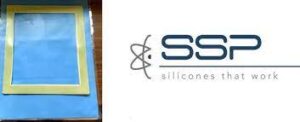A conductive elastomer is a specialized class of rubber-like materials engineered to conduct electricity while retaining the flexibility, resilience, and environmental resistance of conventional elastomers. These unique materials bridge the gap between electrical and mechanical performance, making them indispensable in applications where components must provide both sealing and electrical continuity.
In fields such as aerospace, defense, telecommunications, automotive, and medical device manufacturing, conductive elastomers are used to create EMI gaskets and EMI O-rings. Understanding what these materials are—and how they work—is essential for engineers who specify components for mission-critical systems.
These conductive elastomer FAQs from SSP explain what engineers need to know.
What is a Conductive Elastomer?
A conductive has two basic components: a polymer matrix and a conductive filler.
Polymer Matrix
The polymer matrix is the base elastomer that provides flexibility, compressibility, and environmental durability. Common base elastomers include silicone, fluorosilicone, EPDM, and neoprene. SSP specializes in EMI shielding silicone materials and products, including EMI fluorosilicones. We also provide a non-silicone based EPDM elastomer.
Conductive Filler
Rubber is a natural insulator, so particles of electrically conductive particles are dispersed throughout the polymer matrix. Examples of fillers include pure silver, silver-plated fills, and nickel-graphite particles. SSP supplies EMI materials and products with silver-aluminum, silver-copper, silver-nickel, or silver-graphite particles. See products by filler material.
How Do EMI Elastomers Conduct Electricity?
Unlike metals, elastomers are inherently non-conductive. The conductive property is introduced through filler loading and dispersion. When the volume fraction of conductive particles reaches a critical threshold (called the percolation threshold), a continuous conductive network forms throughout the polymer matrix.
This conductive network allows electrons to travel through the gasket, creating a low-impedance path that can effectively bond two conductive surfaces. When used in EMI shielding applications, this ensures that stray electromagnetic signals are grounded or reflected, thereby preventing interference with sensitive electronic components.
For EMI shielding, a surface resistivity of less than 0.01 ohm/cm is typically required. Engineers must balance conductivity with other performance requirements like compression and environmental sealing, however. SSP can help you with material selection and has an in-house research and development laboratory.
What Types of Conductive Elastomers are Available?
Conductive elastomers can be classified based on both the base material and the conductive filler.
By Elastomer Matrix
SSP offers silicone, fluorosilicone, and EPDM based materials.
- Silicone-based elastomers are popular because of their wide temperature range (−55 °C to +200 °C), weather resistance, and compression properties. They are widely used in military, aerospace, and telecom applications.
- Fluorosilicone-based elastomers offer better resistance to fuels, oils, and solvents, making them suitable for harsh environments such as aircraft fuel systems or under-the-hood automotive components.
- EPDM-based elastomers are cost-effective alternatives with good water and weather resistance, commonly used in commercial applications.
By Conductive Filler Type
- Silver-Plated Aluminum (Ag/Al) fillers provide excellent shielding effectiveness and corrosion resistance. They are widely used in military and aerospace systems.
- Silver-Plated Copper (Ag/Cu) fillers provide high conductivity, often used in applications where maximum shielding is required, though it can be more prone to corrosion in humid environments.
- Nickel-Plated Graphite (Ni/C) fillers offer a lower-cost alternative that offers good performance in many applications, especially commercial electronics.
What are the Key Properties of Conductive Elastomers
When selecting a conductive elastomer, engineers should evaluate electrical and other properties. There are two key electrical properties. Volume resistivity is measured in ohms per centime. Shielding effectiveness is measured in decibels (dB) over frequency. Key mechanical properties include compression set resistance, tensile strength, and elongation at break.
Engineers also need to consider environmental resistance. Properties include temperature range, UV and ozone resistance, and chemical compatibility. Corrosion resistance is important in marine environments where dissimilar materials are present. For example, SSP2529 and SSP2551 help minimize galvanic corrosion with aluminum housings.
What are Some Conductive Elastomer Applications?
Conductive elastomers are used for EMI shielding gaskets and EMI O-rings.
EMI Shielding Gaskets
One of the most important uses of conductive elastomers is in EMI shielding gaskets. These gaskets are placed between conductive surfaces—such as enclosure doors and panels—to ensure both an environmental seal and a conductive path. This is critical in avionics and radar systems, military electronics, telecommunication base stations, and medical equipment housings.
For RF connectors and shielded cable interfaces, conductive elastomer gaskets ensure low contact resistance and EMI shielding integrity. Conductive elastomers can be molded or extruded into complex shapes, allowing engineers to integrate EMI shielding directly into mechanical designs without separate metal shielding parts.
EMI O-Rings
In fuel systems, electronics enclosures, and sensor interfaces, conductive elastomer O-rings provide sealing against fluids while also grounding components. SSP makes standard and custom EMI O-rings, including products in M83528 sizes.
What are the Advantages of Conductive Elastomers?
Compared to metal, which can also provide EMI shielding, conductive elastomers offer these advantages.
- Dual Functionality: They provide both environmental sealing and electrical shielding, reducing the number of components required in a system.
- Design Flexibility: Can be extruded, molded, or die-cut into virtually any shape, enabling tight integration with enclosures.
- Durability: Resistant to aging, UV, ozone, and temperature extremes, especially when silicone-based.
- Weight Reduction: Replacing metal shielding with lightweight conductive elastomers can reduce total system weight, which is especially valuable in aerospace and mobile electronics.
- Corrosion Resistance: Unlike metal mesh gaskets, many conductive elastomers minimize galvanic corrosion, especially when selected to match the surrounding materials.
What are Some Challenges and Design Considerations?
While conductive elastomers offer many benefits, engineers must also account for these and other design challenges.
- Cost: High-conductivity fillers like silver can make these materials more expensive than conventional gaskets.
- Compression Requirements: Conductive elastomers often require a controlled compression (typically 10–30%) to maintain electrical continuity without damaging the part.
- Galvanic Corrosion: If the conductive filler and the mating surface metal are dissimilar, galvanic corrosion may occur. Material compatibility is crucial.
- Environmental Factors: Exposure to fuels, chemicals, or high humidity can degrade some fillers or elastomers, so correct material selection is essential. Fluorosilicones provide expanded fuel and chemical resistance.
- Aging: Over long periods, conductive networks may degrade if the filler corrodes or migrates, especially in harsh conditions.
How are Conductive Elastomers Fabricated?
Conductive elastomers can be fabricated through molding, extrusion and bonding, flash cutting, or die cutting. Common fabricated methods include:
- Compression molding for custom gasket shapes and O-rings
- Extrusion for continuous profiles and cords, and bonding for low volumes of O-rings.
- Flash cutting for lower volumes of flat gaskets, including prototypes
- Die-cutting for higher volumes of flat gaskets
What are Some Tests and Standards for Conductive Elastomers?
Testing of conductive elastomers often involves:
- Volume Resistivity (ASTM D991) to measure electrical properties.
- Shielding Effectiveness (MIL-DTL-83528) for military-grade EMI gaskets.
- Compression Set (ASTM D395) and Tensile Testing (ASTM D412) for mechanical properties.
MIL-DTL-83528 is often required for aerospace and defense applications. SSP offers MIL-DTL-83528 materials that are part of the Qualified Product List (QPL) from the U.S. Defense Logistics Agency (DLA).
What are Some Key Conductive Elastomer Trends?
As electronics become more compact and powerful, EMI shielding requirements are growing. Emerging trends include:
- Hybrid conductive elastomers with multiple filler types for improved performance.
- Lightweight, non-silver formulations to reduce cost and environmental impact.
- Thermal conductivity integration with EMI shielding to handle heat dissipation in electronics.
- Advanced manufacturing methods like additive manufacturing to produce complex gasket geometries.
Ask SSP for the Right Conductive Elastomer
A conductive elastomer is far more than just “rubber that conducts electricity.” It is a carefully engineered material that enables electrical continuity, EMI/RFI shielding, and environmental protection in demanding applications.
For engineers, selecting the right conductive elastomer involves balancing electrical performance, mechanical properties, environmental durability, and cost. When properly specified and applied, conductive elastomers can simplify designs, improve reliability, and ensure compliance with electromagnetic compatibility requirements.
As technology advances, these materials will continue to play a crucial role in connecting—and protecting—the world’s most critical electronic systems. Contact SSP to discuss your application and request a quote.





